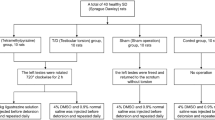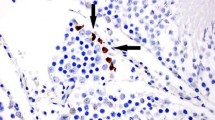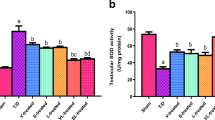Abstract
This experiment was carried out to investigate the effect of endogenous nitric oxide (NO) on the ischemia-reperfusion injury of testis.Testicular ischemia was achieved by twisting the right testis and spermatic cord 1080 counter-clockwise for 30 minutes and reperfusion was allowed for 30 minutes after detorsion of 33 rats. Animals were treated with normal saline in controls just before detorsion,NG-nitro-L-arginine methyl ester (L-NAME), and L-arginine (L-arg) in others.The tissue damage was evaluated with light microscopy, malondialdehyde (MDA) level in tissue, and the blood flow measurement using 133xenon (Xe) clearence technique.MDA indicator of reperfusion injury increased 25% after detorsion when only normal saline was given, L-NAME further increased MDA, L-arginin decreased MDA to control level.Conclusion: L-arginin infusion during the detorsion reduced the reperfusion injury of testis and improved the testicular blood flow after the detorsion.
Similar content being viewed by others
References
Akgur FM, Kilinc K, Tanyel FC et al. Ipsilateral and contralateral testicular biochemical acute changes after unilateral testicular torsion and detorsion. Urology 1994; 44: 413.
Aydin S, Ugras S, Odabas O et al. Experimental testicular torsion and its effects on the contralateral testicle. Int Urol Nephrol 1997; 29: 661.
Becker EJ, Prillaman HM, Turner TT. Microvascular blood flow is altered after repair of testicular torsion in the rat. J Urol 1997; 157: 1493.
Bergh A, Damber JE, Marklund SE. Morphological changes induced by short term ischemia in rat testis are not affected by treatment with superoxide dismutase or catalase. J Androl 1988; 9: 15.
Carden DL, Granger DN. Pathophysiology of ischemia-reperfusioninjury. Jpathol 2000; 190: 255.
Ciftci AO, Muftuoglu S, Cakar N, Tanyel FC. Histological evidence of decreased contralateral testicular blood flow during ipsilateral testicular torsion. Br J Urol 1997; 80: 783.
Ferguson ND, Granton JT. Inhaled nitric oxide for hypoexemic respiratory failure: passing bad gas? C M A J 2000; 162: 85.
Janetschek G, Schreckenberg F, Grimm W, Marberger M. Hemodynamic effects of experimental testicular torsion. Urol Res 1987; 15: 303.
Kannan MS, Guiang S, Johnson DE. Nitric oxide: biological role and clinical uses. Indian J Pediatr 1998; 65: 333.
Kizilcan F, Bernay I, Tanyel FC et al. Ipsilateral and contralateral testicular blood flows during unilateral testicular torsion by 133Xe clearance technique. Int Urol Nephrol 1992; 24: 515.
Kosar A, Sarica K, Kupeli B et al. Testicular torsion: evaluation of contralateral testicular histology. Inti Urol Nephrol 1997; 29: 351.
Kubes P. The role of adhesion molecules nad nitric oxide in intestinal and hepatic ischemia-reperfusion. Hepatogastroenterology 1999; 46: 1458.
Mikuz G. Testicular torsion: simple grading for histological evaluation of tissue damage. Appl Pathol 1985; 3: 134.
Palmer JS, Plzak LF, Cromie WJ. Comparison of blood flow and histological changes in rat models of testicular ischemia. J Urol 1997; 158: 1138.
Prillaman HM, Turner TT. Rescue of testicular function after acute experimental torsion. J Urol 1997; 157: 340.
Saba M, Morales CR, De Lamirande E, Gagnon C. Morphological and biochemical changes following acute unilateral testicular torsion in prepubertal rats. J Urol 1997; 157: 1149.
Salman AB, Kilinc K, Tanyel FC. Torsion of only spermatic cord in the absence of testis and/epididymis results incontralateral testicular hypoxia. UrolRes 1997; 25: 413.
Schoenberg MH, Beger HG. Reperfusion injury after intestinal ischemia. Crit Care Med 1993; 21: 1376.
Tanyel FC, Buyukpamukcu N, Hicsonmez A. Contralateral testicular blood flow during unilateral testicular torsion. Br J Urol 1989; 63: 522.
Wax SH. Measurement of testicular blood flow by percutaneous injection of 133 Xe. Invest Urol 1971; 9: 167.
Weinbroum AA, Kluger Y, Shapira I, Rudick V. Methylene blue aboliches aortal tone impairment induced by liver ischemia-reperfusion in a dose response manner: an isolated perfused double-organ rat model study. Shock 2001; 15: 226.
Author information
Authors and Affiliations
Rights and permissions
About this article
Cite this article
Barlas, M., Hatiboğlu, C. The effect of nitric oxide in testicular ischemia-reperfusion injury. Int Urol Nephrol 34, 81–86 (2002). https://doi.org/10.1023/A:1021311029572
Issue Date:
DOI: https://doi.org/10.1023/A:1021311029572




